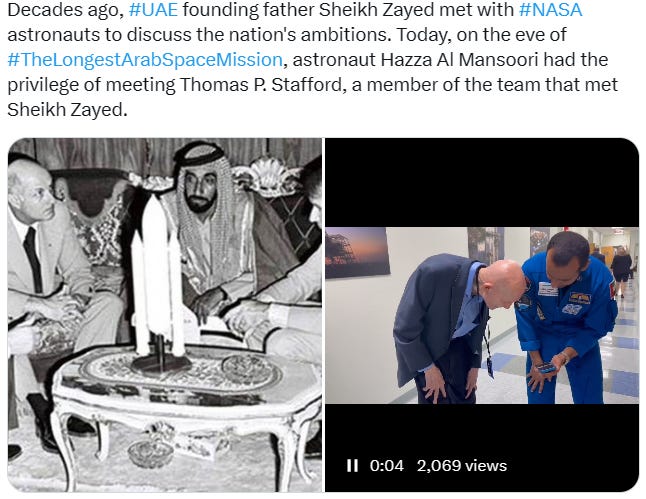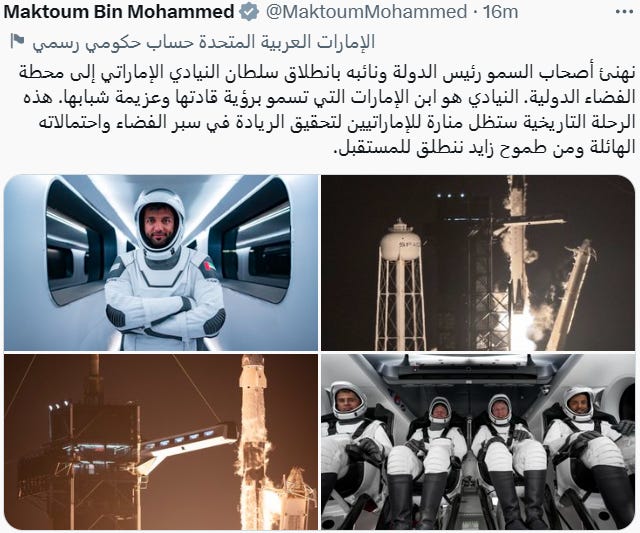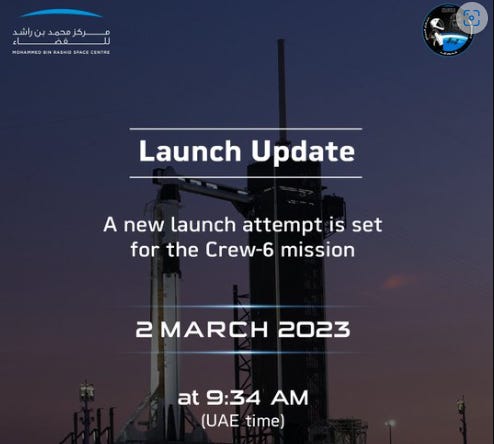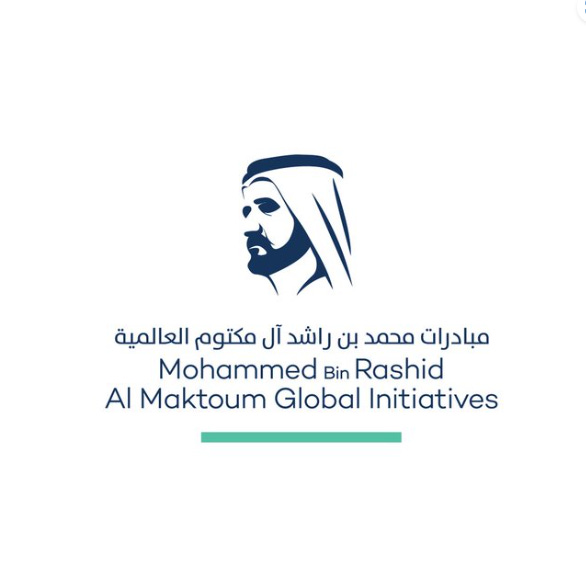828 meters of Burj Khalifa is not enough for UAE, a country in which the ruler (MBZ) has a very warm relation, joyful interaction with Indonesia’s President Jokowi. In the last 7 hours, UAE nationalities and the UAE government watched the live launch of the CREW-6 mission at the Kennedy Space Center in Florida. The UAE wants 828 billion kilometers, or more, to go to space. Astronaut Sultan AlNeyadi and his Crew-6 colleagues are heading to the Launch Complex 39A at the Kennedy Space Center.
I remember the story of NATGEO documentary about Arab, 20 years ago (or more). In a Natgeo documentary, a Bechtel representative and ARAMCO (from US nationalities) must (mandatory) “say hello”, begging for permission from several heads of tribes (or something like this) before starting exploration of oil. So U.S. nationalities use a phone to call several leads/heads of tribes. The Arabian side gathered in some building near Riyadh, and provided phones too, so (in 1950s or something), BECHTEL & ARAMCO in DC could call with the Arabian side in Riyadh. The very heartbreak, several Arabian sides thought that the voice from the phone is (voice of) evil.
After losing near Vienna, also losing in the vicinity of Buda River and Pest River, Islamic Leadership (Khilafa, Khulafa) faced a drop - dark age 3-4 centuries. Turkiye, part of Islamic Leadership, called “the sickman of Europe”.
Indonesia, the biggest Islamic-population country (since the 12th century), starting in the 16th century got colonized by the Dutch (then French, back again to Dutch, was UK, then Dutch again, and in last- 1942 until 1945, invaded by Japan / Nippon).
But today is a historical day for Arab. The longest Arab space mission in history. The 3rd moslem country (after Iran, Malaysia), regardless one Director of division in NASA is Palestinian. Sadly, because of the Challenger Tragedy, the Indonesian Government canceled sending Indonesian nationalities to space in the 80s.
Actually, the UAE is not alone for (aiming) to go to space among Arabian countries. In previous years, Gulf funds had a reputation for snapping up trophy assets. Now, they are being more tactical — using their wealth to claim a bigger role on the world stage, diversify their economies and win geopolitical influence. Oman has a rare dream, not like Qatar (host World Cup 2022) and Saudi (try to be winning bid of World Cup 2030): Oman will host the Middle East’s first spaceport. The project will be located in the port town of Duqm, dubbed the Etlaq Space Launch Complex.
Due to its equatorial positioning, authorities believe the site to make an ideal spot for launches, as the rocket can take advantage of the Earth’s rotational speeds. “Internationally verified studies have identified that Wilayat Al-Duqm’s equatorial positioning places it in the top 10 most efficient rocket launch latitudes in the world. Another “Top 10” is Biak Indonesia, one degree below the equator, which makes it ideal for launching spacecraft as less fuel is needed to reach orbit (and Biak) also has several features that make it attractive for anyone with space ambitions, It is flush with nickel and copper - both used to manufacture rockets. Back again to Oman, energy firm OQ SAOC plans to sell up to 49% of its oil drilling unit Abraj Energy Services SAOC in an initial public offering, kick-starting the sultanate’s push to join a listings boom sweeping through the Middle East. The Oman sultanate is looking to join the Gulf’s IPO boom.
Currently, Oman’s economy is firmly entrenched in a cycle of hydro-carbon dependency. In Oman, oil and gas accounts for nearly 50% of GDP, 70% of exports, and 71% of total government revenue.
This reliance on oil and gas has been posited as Oman’s biggest risk, and the country has been on an all out mission to develop other sectors of its economy, aiming to cut its share of hydro-carbon derived GDP in half by 2020. To these ends, the country has earmarked roughly $106 billion to invest in industries like transportation, tourism, and real estate, with projects to create a new railway network, new airports, enhanced seaports, new cities — a la Duqm — currently underway. The research firm BMI forecasted that the Sino-Oman Industrial City will be a major factor in the rise of Oman’s construction sector, which is predicted to double its growth rate by 2019.
The location of the port/SEZ combo at Duqm fits snuggly into the bosom of China’s Maritime Silk Road — Beijing’s vision of three supercharged sea routes between China and Europe and Africa that are serving as a framework for the development of a plethora of Chinese-owned ports and other mega-projects. From an established basecamp at Duqm, China will be able to better access and secure their energy and trade supply lines throughout the Middle East and East Africa.
It is also probably no coincidence that 77.1% (2015) of Oman’s crude oil and condensate exports go to China.
Oman can cooperate with NASA, or with Russia, or ESA (European Space Agency), or even with China for the Space Program (like current partnership cooperation Oman - China on construction - built a new city). But today, UAE is the first ever Arabian (not Farsi, Persian nation) to send a human to space.








